Leadership Report: Exploring Styles, Theories and Self-Reflection
VerifiedAdded on 2022/12/26
|11
|2299
|92
Report
AI Summary
This report delves into the multifaceted concept of leadership, examining various leadership styles such as authoritarian, democratic, and laissez-faire approaches, along with the traits and characteristics associated with effective leadership. It explores prominent leadership theories, including trait theory, behavioral theory, contingency theory, and situational theory, elucidating how these frameworks explain the emergence and impact of leaders. The report analyzes leadership functions, such as goal setting, organizing, and motivation, and also discusses the qualities of a good leader. Furthermore, it includes a critical self-reflection on the author's leadership effectiveness, drawing upon personal experiences and insights. The report concludes with a review of the relevant theories and recommendations for broad aspects of leadership, emphasizing the importance of communication, technical skills, and genuine interaction with employees. The report is a valuable resource for anyone seeking to understand and improve their leadership capabilities. The document is contributed by a student to be published on the website Desklib. Desklib is a platform which provides all the necessary AI based study tools for students.
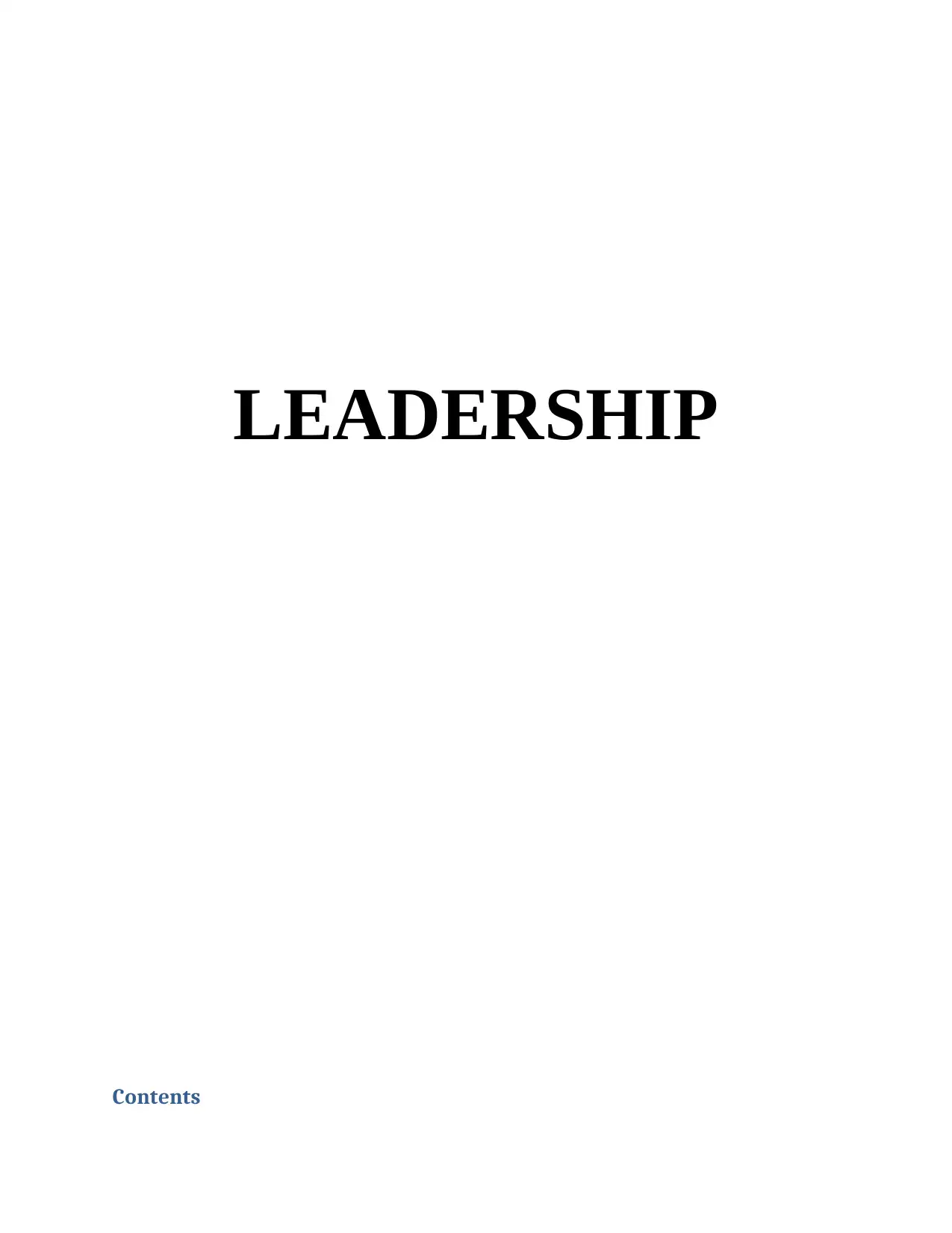
LEADERSHIP
Contents
Contents
Paraphrase This Document
Need a fresh take? Get an instant paraphrase of this document with our AI Paraphraser
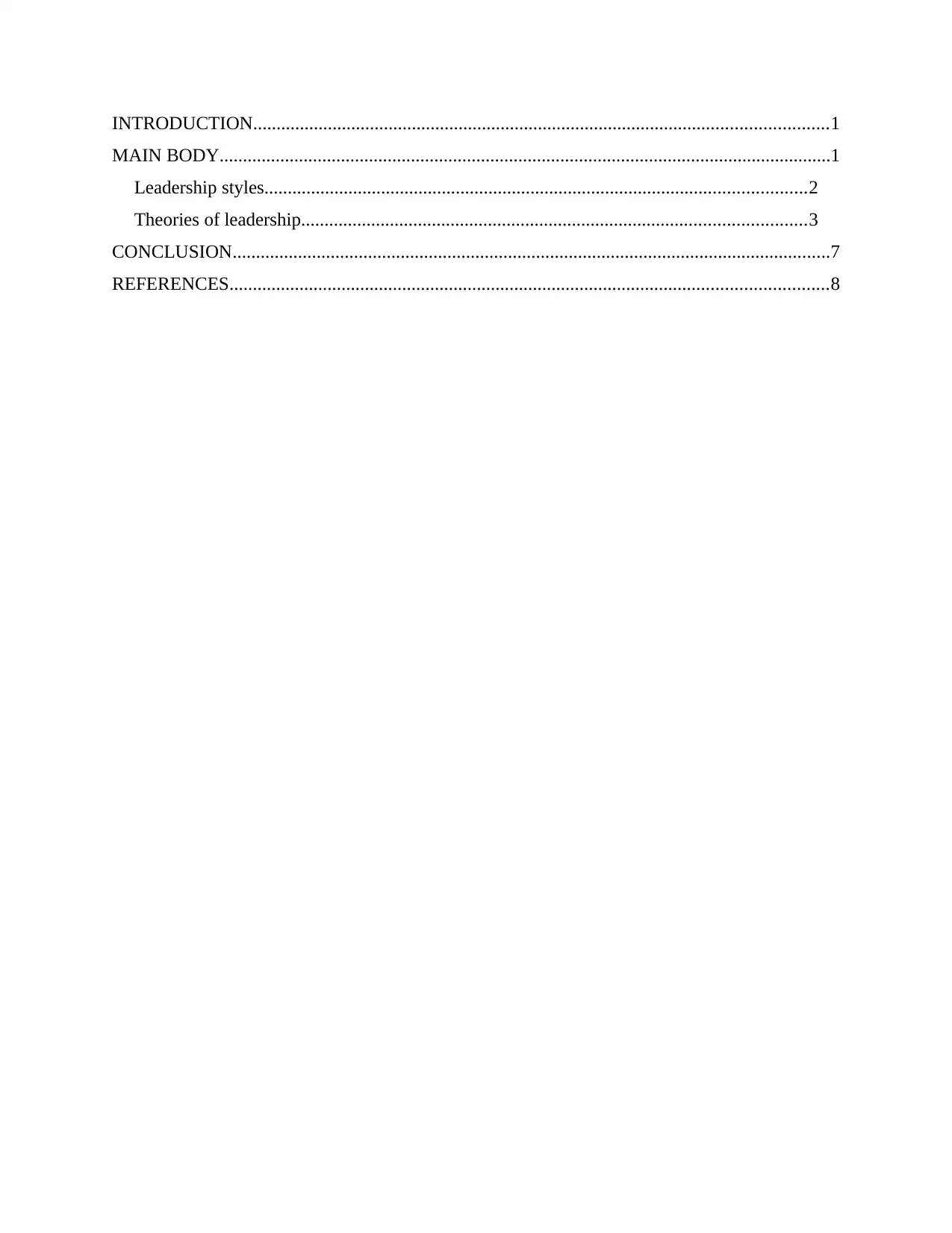
INTRODUCTION...........................................................................................................................1
MAIN BODY...................................................................................................................................1
Leadership styles....................................................................................................................2
Theories of leadership............................................................................................................3
CONCLUSION................................................................................................................................7
REFERENCES................................................................................................................................8
MAIN BODY...................................................................................................................................1
Leadership styles....................................................................................................................2
Theories of leadership............................................................................................................3
CONCLUSION................................................................................................................................7
REFERENCES................................................................................................................................8
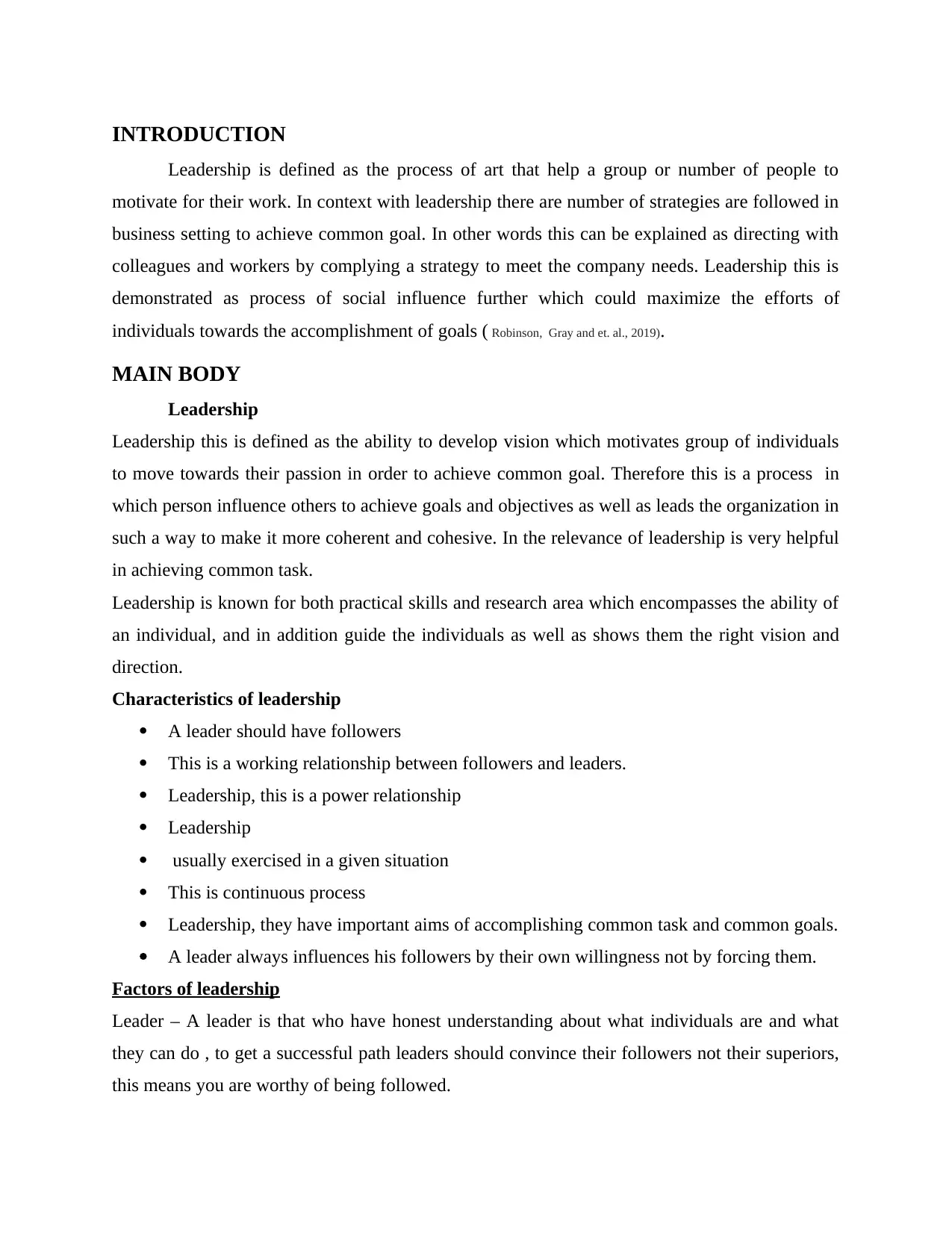
INTRODUCTION
Leadership is defined as the process of art that help a group or number of people to
motivate for their work. In context with leadership there are number of strategies are followed in
business setting to achieve common goal. In other words this can be explained as directing with
colleagues and workers by complying a strategy to meet the company needs. Leadership this is
demonstrated as process of social influence further which could maximize the efforts of
individuals towards the accomplishment of goals ( Robinson, Gray and et. al., 2019).
MAIN BODY
Leadership
Leadership this is defined as the ability to develop vision which motivates group of individuals
to move towards their passion in order to achieve common goal. Therefore this is a process in
which person influence others to achieve goals and objectives as well as leads the organization in
such a way to make it more coherent and cohesive. In the relevance of leadership is very helpful
in achieving common task.
Leadership is known for both practical skills and research area which encompasses the ability of
an individual, and in addition guide the individuals as well as shows them the right vision and
direction.
Characteristics of leadership
A leader should have followers
This is a working relationship between followers and leaders.
Leadership, this is a power relationship
Leadership
usually exercised in a given situation
This is continuous process
Leadership, they have important aims of accomplishing common task and common goals.
A leader always influences his followers by their own willingness not by forcing them.
Factors of leadership
Leader – A leader is that who have honest understanding about what individuals are and what
they can do , to get a successful path leaders should convince their followers not their superiors,
this means you are worthy of being followed.
Leadership is defined as the process of art that help a group or number of people to
motivate for their work. In context with leadership there are number of strategies are followed in
business setting to achieve common goal. In other words this can be explained as directing with
colleagues and workers by complying a strategy to meet the company needs. Leadership this is
demonstrated as process of social influence further which could maximize the efforts of
individuals towards the accomplishment of goals ( Robinson, Gray and et. al., 2019).
MAIN BODY
Leadership
Leadership this is defined as the ability to develop vision which motivates group of individuals
to move towards their passion in order to achieve common goal. Therefore this is a process in
which person influence others to achieve goals and objectives as well as leads the organization in
such a way to make it more coherent and cohesive. In the relevance of leadership is very helpful
in achieving common task.
Leadership is known for both practical skills and research area which encompasses the ability of
an individual, and in addition guide the individuals as well as shows them the right vision and
direction.
Characteristics of leadership
A leader should have followers
This is a working relationship between followers and leaders.
Leadership, this is a power relationship
Leadership
usually exercised in a given situation
This is continuous process
Leadership, they have important aims of accomplishing common task and common goals.
A leader always influences his followers by their own willingness not by forcing them.
Factors of leadership
Leader – A leader is that who have honest understanding about what individuals are and what
they can do , to get a successful path leaders should convince their followers not their superiors,
this means you are worthy of being followed.
⊘ This is a preview!⊘
Do you want full access?
Subscribe today to unlock all pages.

Trusted by 1+ million students worldwide
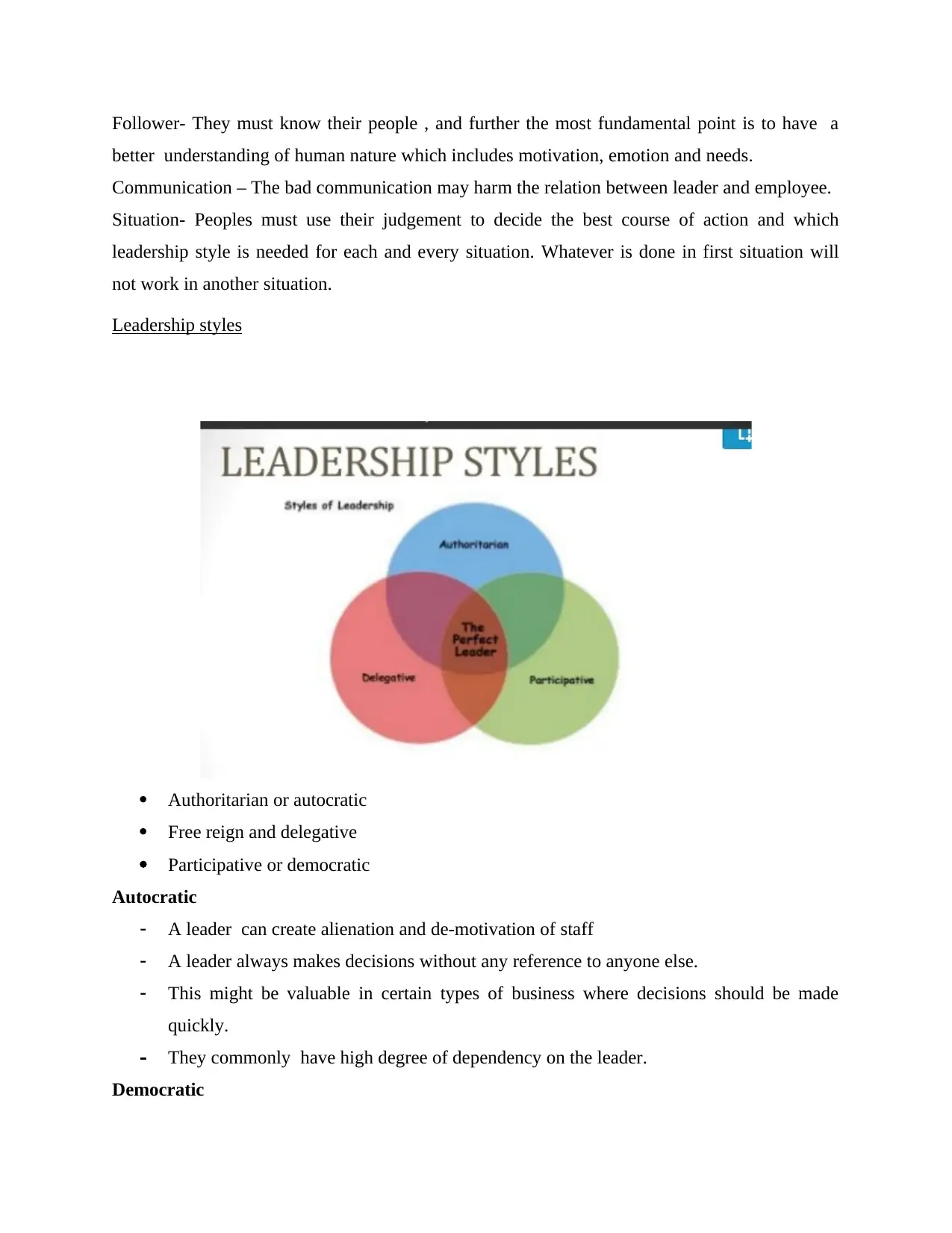
Follower- They must know their people , and further the most fundamental point is to have a
better understanding of human nature which includes motivation, emotion and needs.
Communication – The bad communication may harm the relation between leader and employee.
Situation- Peoples must use their judgement to decide the best course of action and which
leadership style is needed for each and every situation. Whatever is done in first situation will
not work in another situation.
Leadership styles
Authoritarian or autocratic
Free reign and delegative
Participative or democratic
Autocratic
A leader can create alienation and de-motivation of staff
A leader always makes decisions without any reference to anyone else.
This might be valuable in certain types of business where decisions should be made
quickly.
They commonly have high degree of dependency on the leader.
Democratic
better understanding of human nature which includes motivation, emotion and needs.
Communication – The bad communication may harm the relation between leader and employee.
Situation- Peoples must use their judgement to decide the best course of action and which
leadership style is needed for each and every situation. Whatever is done in first situation will
not work in another situation.
Leadership styles
Authoritarian or autocratic
Free reign and delegative
Participative or democratic
Autocratic
A leader can create alienation and de-motivation of staff
A leader always makes decisions without any reference to anyone else.
This might be valuable in certain types of business where decisions should be made
quickly.
They commonly have high degree of dependency on the leader.
Democratic
Paraphrase This Document
Need a fresh take? Get an instant paraphrase of this document with our AI Paraphraser
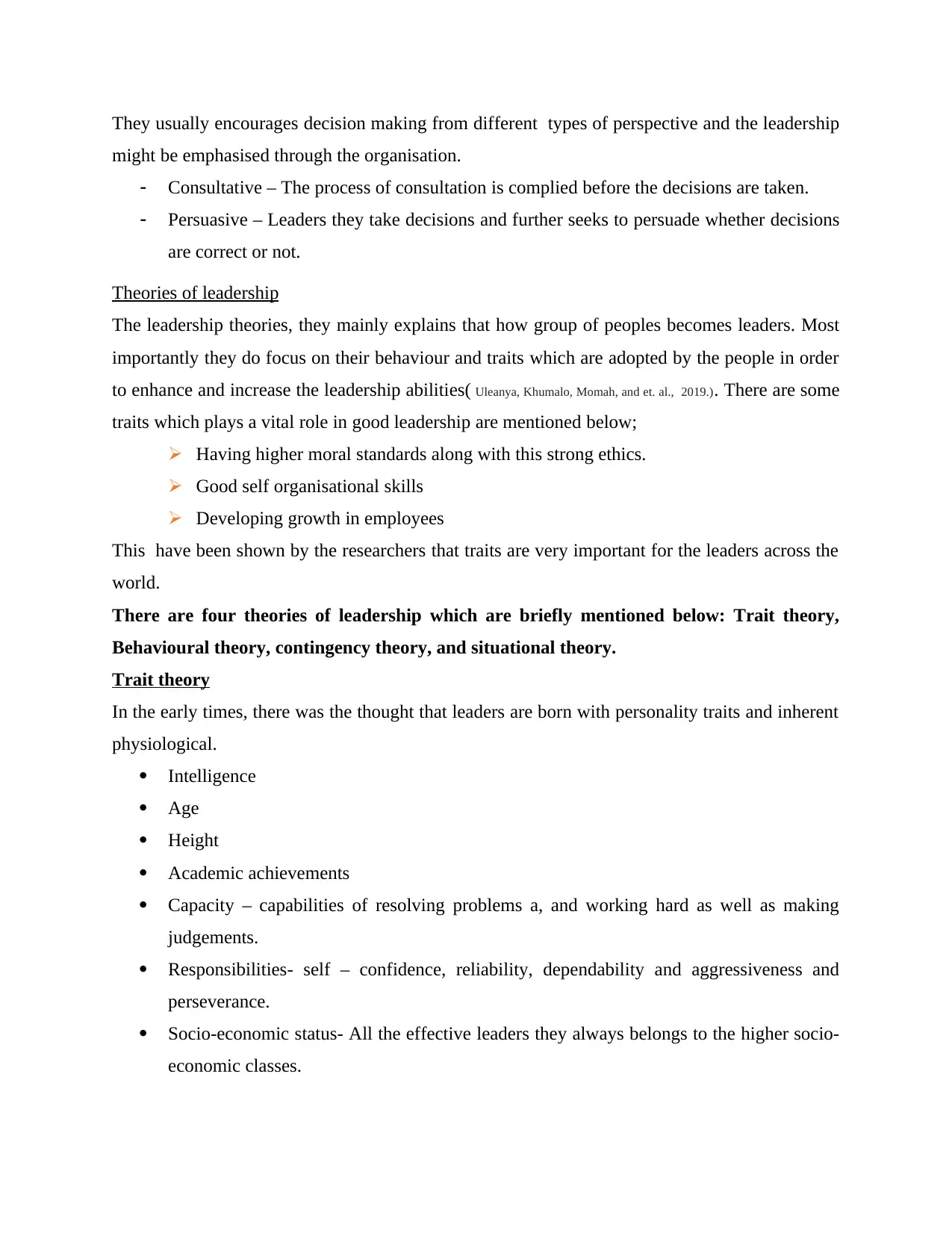
They usually encourages decision making from different types of perspective and the leadership
might be emphasised through the organisation.
Consultative – The process of consultation is complied before the decisions are taken.
Persuasive – Leaders they take decisions and further seeks to persuade whether decisions
are correct or not.
Theories of leadership
The leadership theories, they mainly explains that how group of peoples becomes leaders. Most
importantly they do focus on their behaviour and traits which are adopted by the people in order
to enhance and increase the leadership abilities( Uleanya, Khumalo, Momah, and et. al., 2019.). There are some
traits which plays a vital role in good leadership are mentioned below;
Having higher moral standards along with this strong ethics.
Good self organisational skills
Developing growth in employees
This have been shown by the researchers that traits are very important for the leaders across the
world.
There are four theories of leadership which are briefly mentioned below: Trait theory,
Behavioural theory, contingency theory, and situational theory.
Trait theory
In the early times, there was the thought that leaders are born with personality traits and inherent
physiological.
Intelligence
Age
Height
Academic achievements
Capacity – capabilities of resolving problems a, and working hard as well as making
judgements.
Responsibilities- self – confidence, reliability, dependability and aggressiveness and
perseverance.
Socio-economic status- All the effective leaders they always belongs to the higher socio-
economic classes.
might be emphasised through the organisation.
Consultative – The process of consultation is complied before the decisions are taken.
Persuasive – Leaders they take decisions and further seeks to persuade whether decisions
are correct or not.
Theories of leadership
The leadership theories, they mainly explains that how group of peoples becomes leaders. Most
importantly they do focus on their behaviour and traits which are adopted by the people in order
to enhance and increase the leadership abilities( Uleanya, Khumalo, Momah, and et. al., 2019.). There are some
traits which plays a vital role in good leadership are mentioned below;
Having higher moral standards along with this strong ethics.
Good self organisational skills
Developing growth in employees
This have been shown by the researchers that traits are very important for the leaders across the
world.
There are four theories of leadership which are briefly mentioned below: Trait theory,
Behavioural theory, contingency theory, and situational theory.
Trait theory
In the early times, there was the thought that leaders are born with personality traits and inherent
physiological.
Intelligence
Age
Height
Academic achievements
Capacity – capabilities of resolving problems a, and working hard as well as making
judgements.
Responsibilities- self – confidence, reliability, dependability and aggressiveness and
perseverance.
Socio-economic status- All the effective leaders they always belongs to the higher socio-
economic classes.
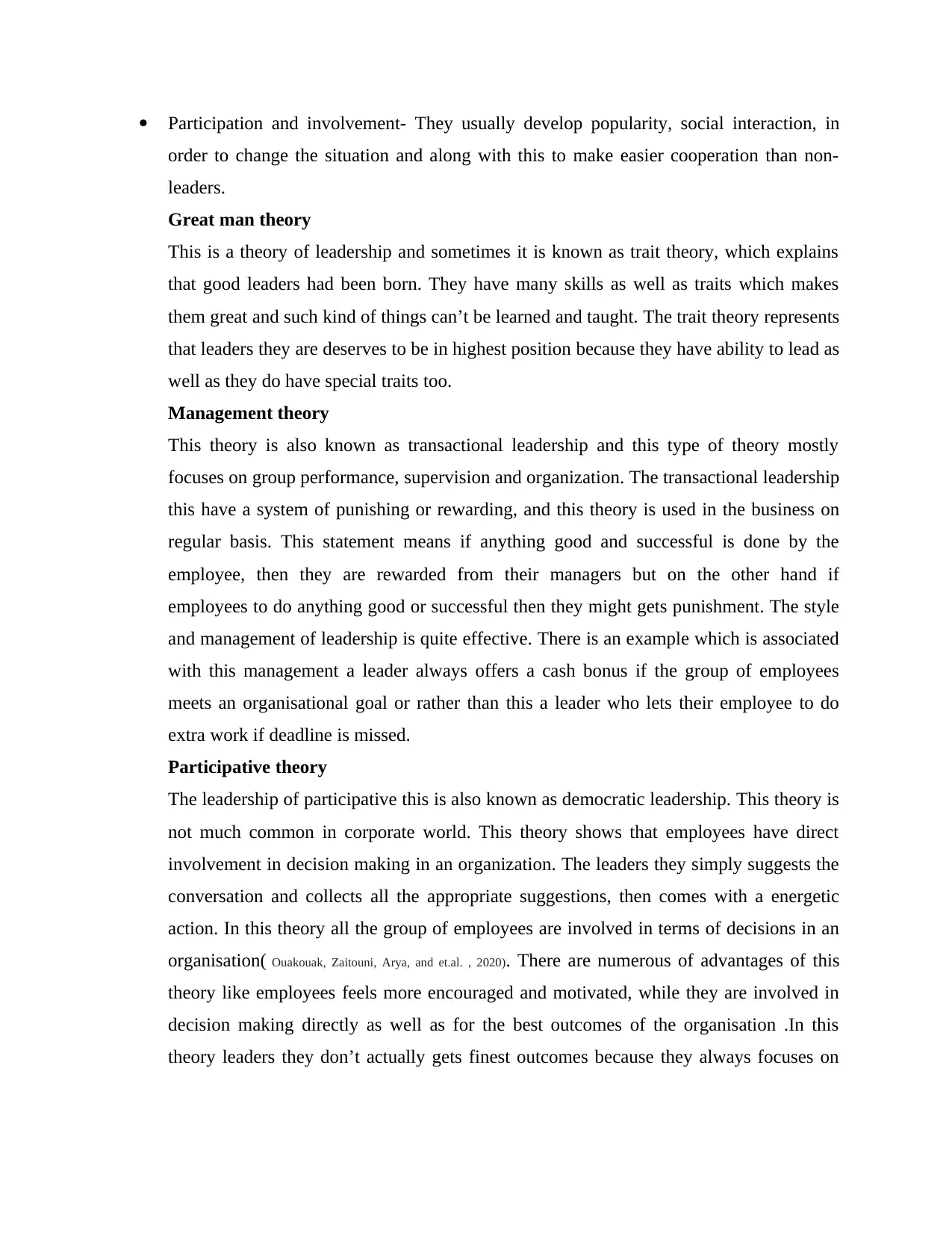
Participation and involvement- They usually develop popularity, social interaction, in
order to change the situation and along with this to make easier cooperation than non-
leaders.
Great man theory
This is a theory of leadership and sometimes it is known as trait theory, which explains
that good leaders had been born. They have many skills as well as traits which makes
them great and such kind of things can’t be learned and taught. The trait theory represents
that leaders they are deserves to be in highest position because they have ability to lead as
well as they do have special traits too.
Management theory
This theory is also known as transactional leadership and this type of theory mostly
focuses on group performance, supervision and organization. The transactional leadership
this have a system of punishing or rewarding, and this theory is used in the business on
regular basis. This statement means if anything good and successful is done by the
employee, then they are rewarded from their managers but on the other hand if
employees to do anything good or successful then they might gets punishment. The style
and management of leadership is quite effective. There is an example which is associated
with this management a leader always offers a cash bonus if the group of employees
meets an organisational goal or rather than this a leader who lets their employee to do
extra work if deadline is missed.
Participative theory
The leadership of participative this is also known as democratic leadership. This theory is
not much common in corporate world. This theory shows that employees have direct
involvement in decision making in an organization. The leaders they simply suggests the
conversation and collects all the appropriate suggestions, then comes with a energetic
action. In this theory all the group of employees are involved in terms of decisions in an
organisation( Ouakouak, Zaitouni, Arya, and et.al. , 2020). There are numerous of advantages of this
theory like employees feels more encouraged and motivated, while they are involved in
decision making directly as well as for the best outcomes of the organisation .In this
theory leaders they don’t actually gets finest outcomes because they always focuses on
order to change the situation and along with this to make easier cooperation than non-
leaders.
Great man theory
This is a theory of leadership and sometimes it is known as trait theory, which explains
that good leaders had been born. They have many skills as well as traits which makes
them great and such kind of things can’t be learned and taught. The trait theory represents
that leaders they are deserves to be in highest position because they have ability to lead as
well as they do have special traits too.
Management theory
This theory is also known as transactional leadership and this type of theory mostly
focuses on group performance, supervision and organization. The transactional leadership
this have a system of punishing or rewarding, and this theory is used in the business on
regular basis. This statement means if anything good and successful is done by the
employee, then they are rewarded from their managers but on the other hand if
employees to do anything good or successful then they might gets punishment. The style
and management of leadership is quite effective. There is an example which is associated
with this management a leader always offers a cash bonus if the group of employees
meets an organisational goal or rather than this a leader who lets their employee to do
extra work if deadline is missed.
Participative theory
The leadership of participative this is also known as democratic leadership. This theory is
not much common in corporate world. This theory shows that employees have direct
involvement in decision making in an organization. The leaders they simply suggests the
conversation and collects all the appropriate suggestions, then comes with a energetic
action. In this theory all the group of employees are involved in terms of decisions in an
organisation( Ouakouak, Zaitouni, Arya, and et.al. , 2020). There are numerous of advantages of this
theory like employees feels more encouraged and motivated, while they are involved in
decision making directly as well as for the best outcomes of the organisation .In this
theory leaders they don’t actually gets finest outcomes because they always focuses on
⊘ This is a preview!⊘
Do you want full access?
Subscribe today to unlock all pages.

Trusted by 1+ million students worldwide
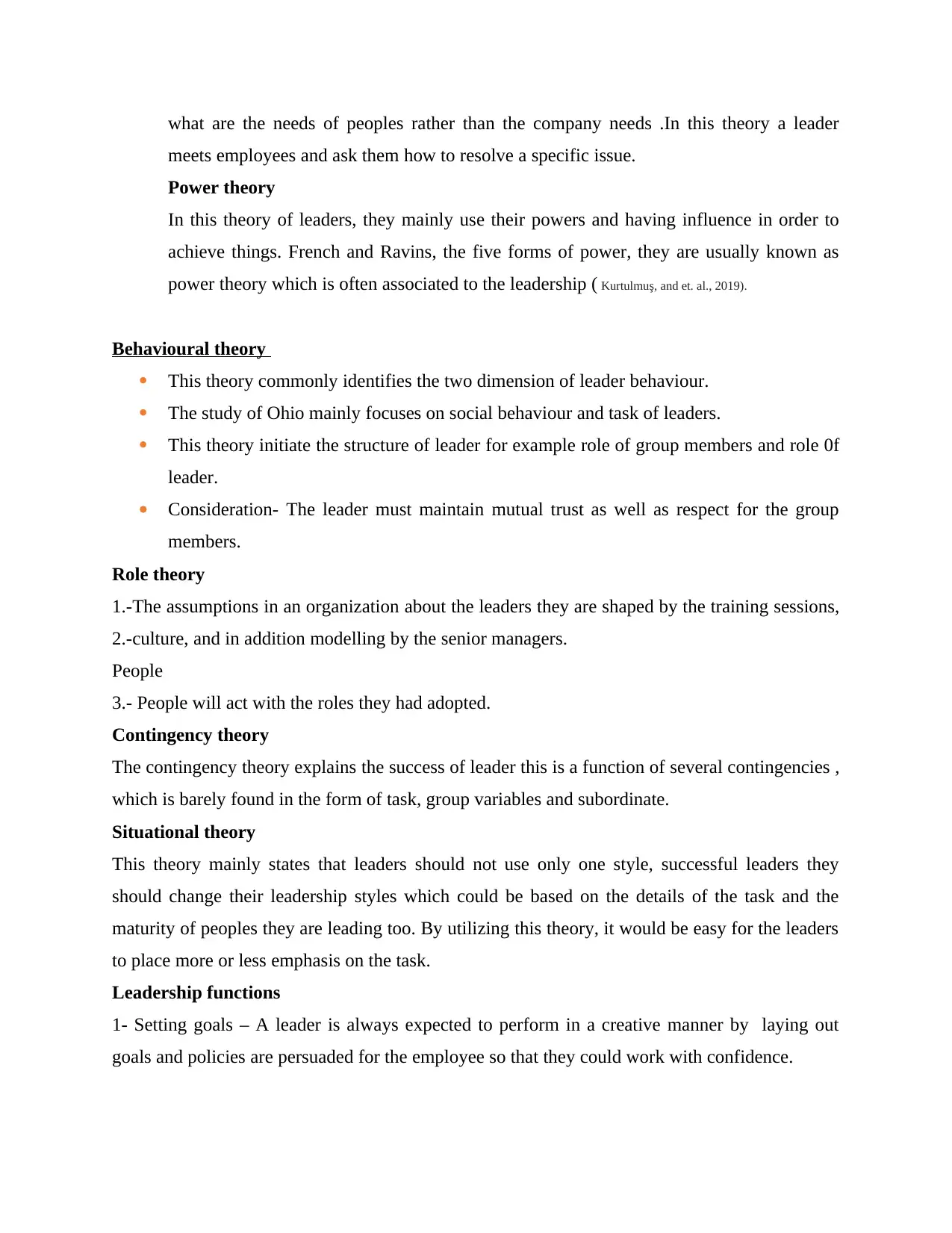
what are the needs of peoples rather than the company needs .In this theory a leader
meets employees and ask them how to resolve a specific issue.
Power theory
In this theory of leaders, they mainly use their powers and having influence in order to
achieve things. French and Ravins, the five forms of power, they are usually known as
power theory which is often associated to the leadership ( Kurtulmuş, and et. al., 2019).
Behavioural theory
This theory commonly identifies the two dimension of leader behaviour.
The study of Ohio mainly focuses on social behaviour and task of leaders.
This theory initiate the structure of leader for example role of group members and role 0f
leader.
Consideration- The leader must maintain mutual trust as well as respect for the group
members.
Role theory
1.-The assumptions in an organization about the leaders they are shaped by the training sessions,
2.-culture, and in addition modelling by the senior managers.
People
3.- People will act with the roles they had adopted.
Contingency theory
The contingency theory explains the success of leader this is a function of several contingencies ,
which is barely found in the form of task, group variables and subordinate.
Situational theory
This theory mainly states that leaders should not use only one style, successful leaders they
should change their leadership styles which could be based on the details of the task and the
maturity of peoples they are leading too. By utilizing this theory, it would be easy for the leaders
to place more or less emphasis on the task.
Leadership functions
1- Setting goals – A leader is always expected to perform in a creative manner by laying out
goals and policies are persuaded for the employee so that they could work with confidence.
meets employees and ask them how to resolve a specific issue.
Power theory
In this theory of leaders, they mainly use their powers and having influence in order to
achieve things. French and Ravins, the five forms of power, they are usually known as
power theory which is often associated to the leadership ( Kurtulmuş, and et. al., 2019).
Behavioural theory
This theory commonly identifies the two dimension of leader behaviour.
The study of Ohio mainly focuses on social behaviour and task of leaders.
This theory initiate the structure of leader for example role of group members and role 0f
leader.
Consideration- The leader must maintain mutual trust as well as respect for the group
members.
Role theory
1.-The assumptions in an organization about the leaders they are shaped by the training sessions,
2.-culture, and in addition modelling by the senior managers.
People
3.- People will act with the roles they had adopted.
Contingency theory
The contingency theory explains the success of leader this is a function of several contingencies ,
which is barely found in the form of task, group variables and subordinate.
Situational theory
This theory mainly states that leaders should not use only one style, successful leaders they
should change their leadership styles which could be based on the details of the task and the
maturity of peoples they are leading too. By utilizing this theory, it would be easy for the leaders
to place more or less emphasis on the task.
Leadership functions
1- Setting goals – A leader is always expected to perform in a creative manner by laying out
goals and policies are persuaded for the employee so that they could work with confidence.
Paraphrase This Document
Need a fresh take? Get an instant paraphrase of this document with our AI Paraphraser
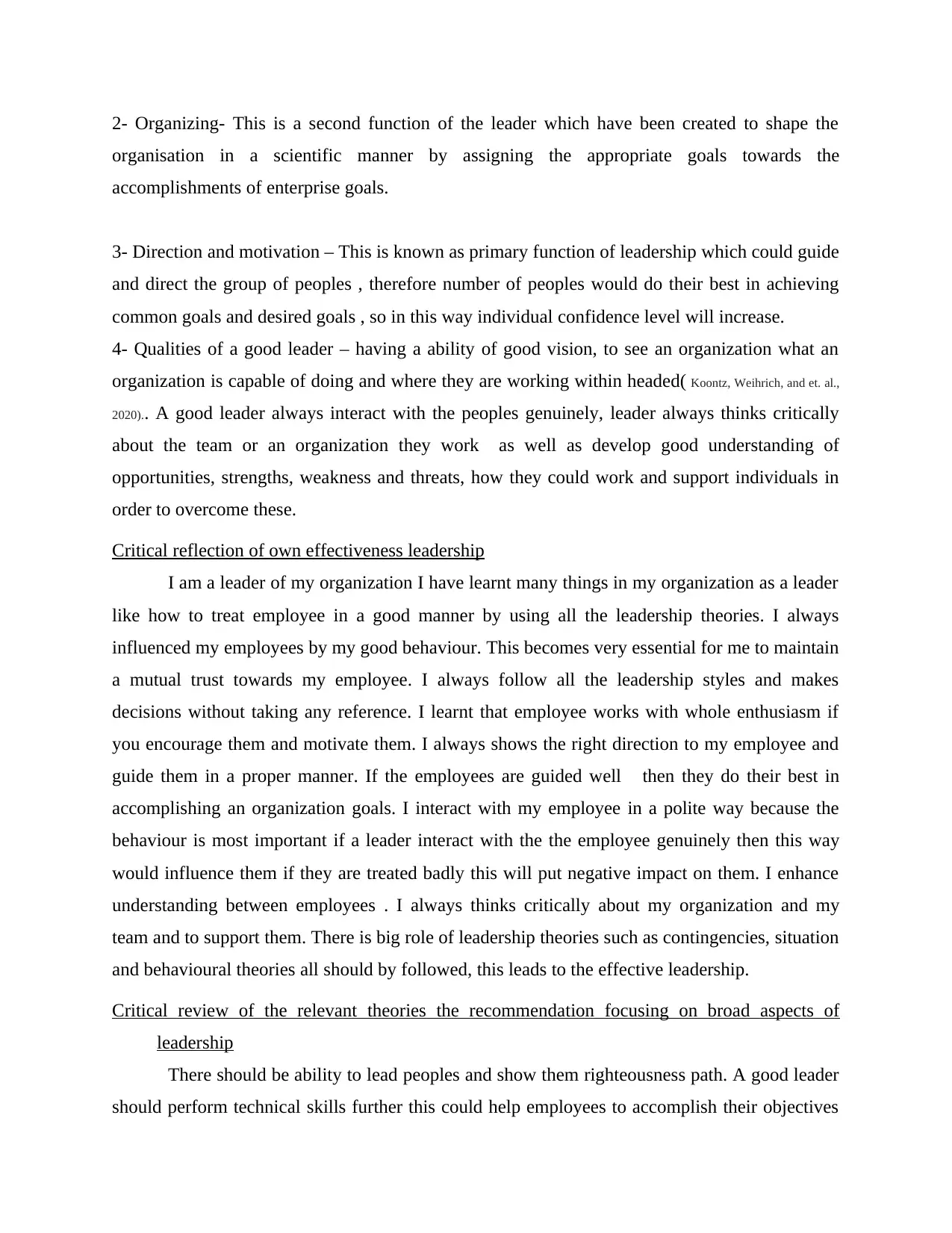
2- Organizing- This is a second function of the leader which have been created to shape the
organisation in a scientific manner by assigning the appropriate goals towards the
accomplishments of enterprise goals.
3- Direction and motivation – This is known as primary function of leadership which could guide
and direct the group of peoples , therefore number of peoples would do their best in achieving
common goals and desired goals , so in this way individual confidence level will increase.
4- Qualities of a good leader – having a ability of good vision, to see an organization what an
organization is capable of doing and where they are working within headed( Koontz, Weihrich, and et. al.,
2020).. A good leader always interact with the peoples genuinely, leader always thinks critically
about the team or an organization they work as well as develop good understanding of
opportunities, strengths, weakness and threats, how they could work and support individuals in
order to overcome these.
Critical reflection of own effectiveness leadership
I am a leader of my organization I have learnt many things in my organization as a leader
like how to treat employee in a good manner by using all the leadership theories. I always
influenced my employees by my good behaviour. This becomes very essential for me to maintain
a mutual trust towards my employee. I always follow all the leadership styles and makes
decisions without taking any reference. I learnt that employee works with whole enthusiasm if
you encourage them and motivate them. I always shows the right direction to my employee and
guide them in a proper manner. If the employees are guided well then they do their best in
accomplishing an organization goals. I interact with my employee in a polite way because the
behaviour is most important if a leader interact with the the employee genuinely then this way
would influence them if they are treated badly this will put negative impact on them. I enhance
understanding between employees . I always thinks critically about my organization and my
team and to support them. There is big role of leadership theories such as contingencies, situation
and behavioural theories all should by followed, this leads to the effective leadership.
Critical review of the relevant theories the recommendation focusing on broad aspects of
leadership
There should be ability to lead peoples and show them righteousness path. A good leader
should perform technical skills further this could help employees to accomplish their objectives
organisation in a scientific manner by assigning the appropriate goals towards the
accomplishments of enterprise goals.
3- Direction and motivation – This is known as primary function of leadership which could guide
and direct the group of peoples , therefore number of peoples would do their best in achieving
common goals and desired goals , so in this way individual confidence level will increase.
4- Qualities of a good leader – having a ability of good vision, to see an organization what an
organization is capable of doing and where they are working within headed( Koontz, Weihrich, and et. al.,
2020).. A good leader always interact with the peoples genuinely, leader always thinks critically
about the team or an organization they work as well as develop good understanding of
opportunities, strengths, weakness and threats, how they could work and support individuals in
order to overcome these.
Critical reflection of own effectiveness leadership
I am a leader of my organization I have learnt many things in my organization as a leader
like how to treat employee in a good manner by using all the leadership theories. I always
influenced my employees by my good behaviour. This becomes very essential for me to maintain
a mutual trust towards my employee. I always follow all the leadership styles and makes
decisions without taking any reference. I learnt that employee works with whole enthusiasm if
you encourage them and motivate them. I always shows the right direction to my employee and
guide them in a proper manner. If the employees are guided well then they do their best in
accomplishing an organization goals. I interact with my employee in a polite way because the
behaviour is most important if a leader interact with the the employee genuinely then this way
would influence them if they are treated badly this will put negative impact on them. I enhance
understanding between employees . I always thinks critically about my organization and my
team and to support them. There is big role of leadership theories such as contingencies, situation
and behavioural theories all should by followed, this leads to the effective leadership.
Critical review of the relevant theories the recommendation focusing on broad aspects of
leadership
There should be ability to lead peoples and show them righteousness path. A good leader
should perform technical skills further this could help employees to accomplish their objectives
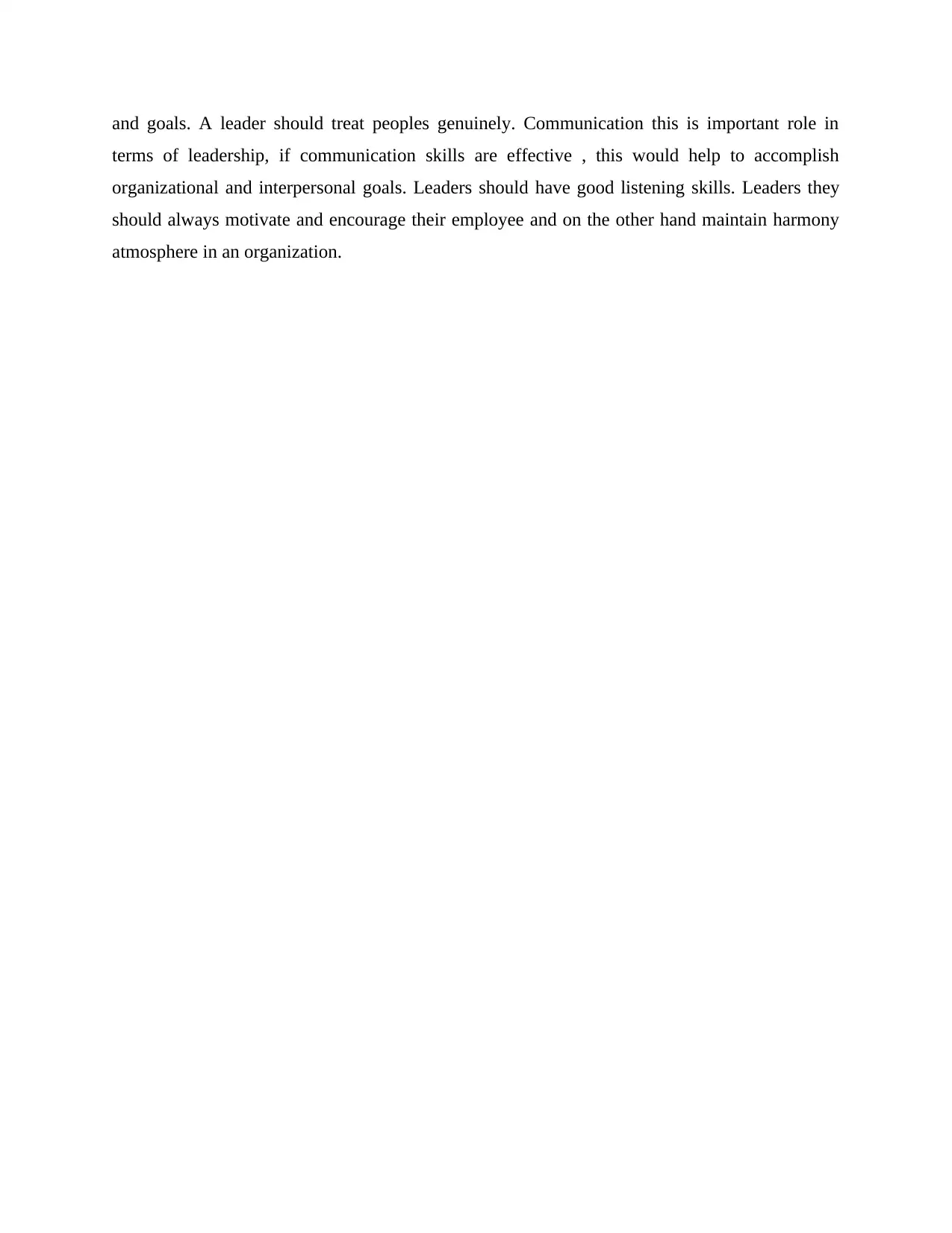
and goals. A leader should treat peoples genuinely. Communication this is important role in
terms of leadership, if communication skills are effective , this would help to accomplish
organizational and interpersonal goals. Leaders should have good listening skills. Leaders they
should always motivate and encourage their employee and on the other hand maintain harmony
atmosphere in an organization.
terms of leadership, if communication skills are effective , this would help to accomplish
organizational and interpersonal goals. Leaders should have good listening skills. Leaders they
should always motivate and encourage their employee and on the other hand maintain harmony
atmosphere in an organization.
⊘ This is a preview!⊘
Do you want full access?
Subscribe today to unlock all pages.

Trusted by 1+ million students worldwide
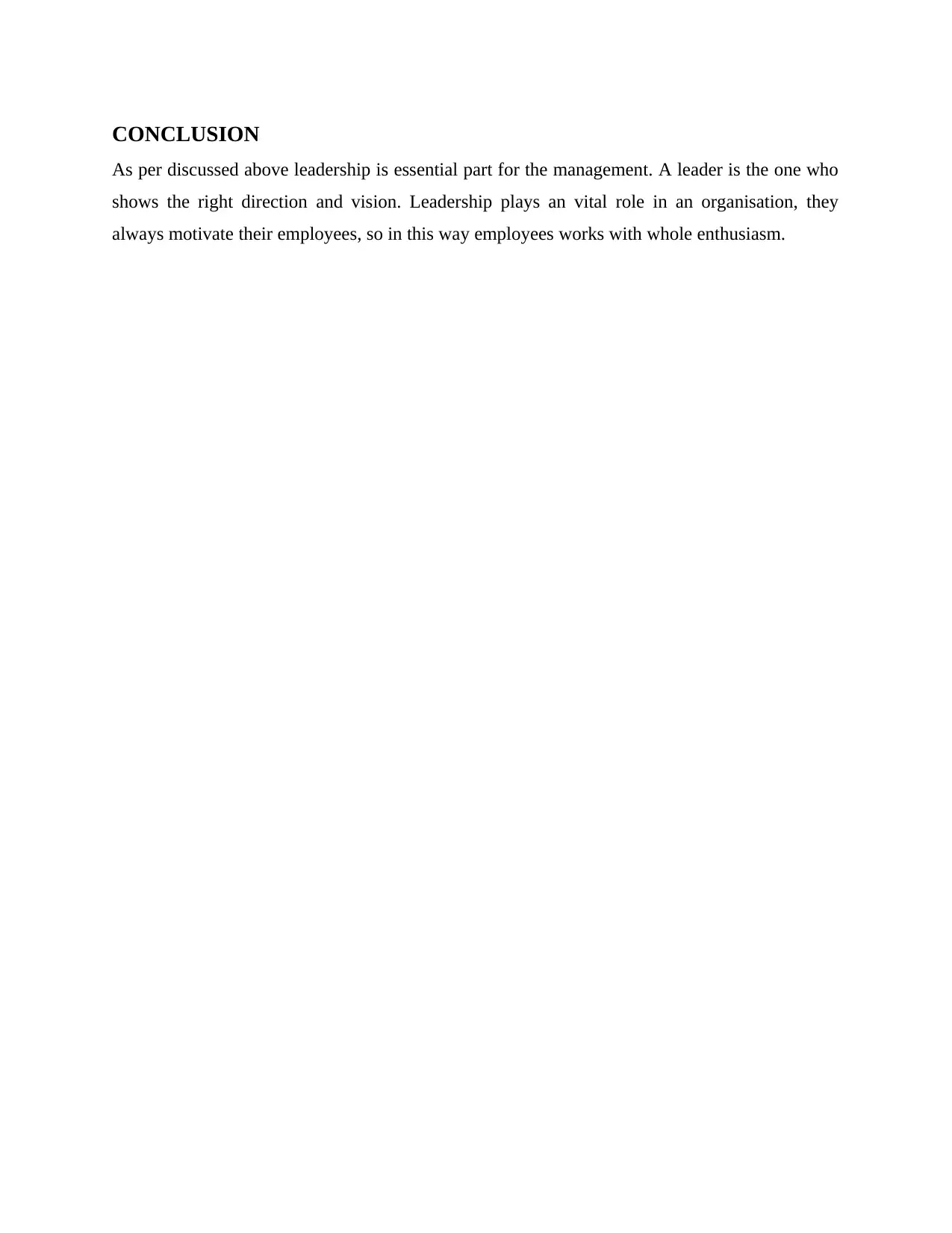
CONCLUSION
As per discussed above leadership is essential part for the management. A leader is the one who
shows the right direction and vision. Leadership plays an vital role in an organisation, they
always motivate their employees, so in this way employees works with whole enthusiasm.
As per discussed above leadership is essential part for the management. A leader is the one who
shows the right direction and vision. Leadership plays an vital role in an organisation, they
always motivate their employees, so in this way employees works with whole enthusiasm.
Paraphrase This Document
Need a fresh take? Get an instant paraphrase of this document with our AI Paraphraser
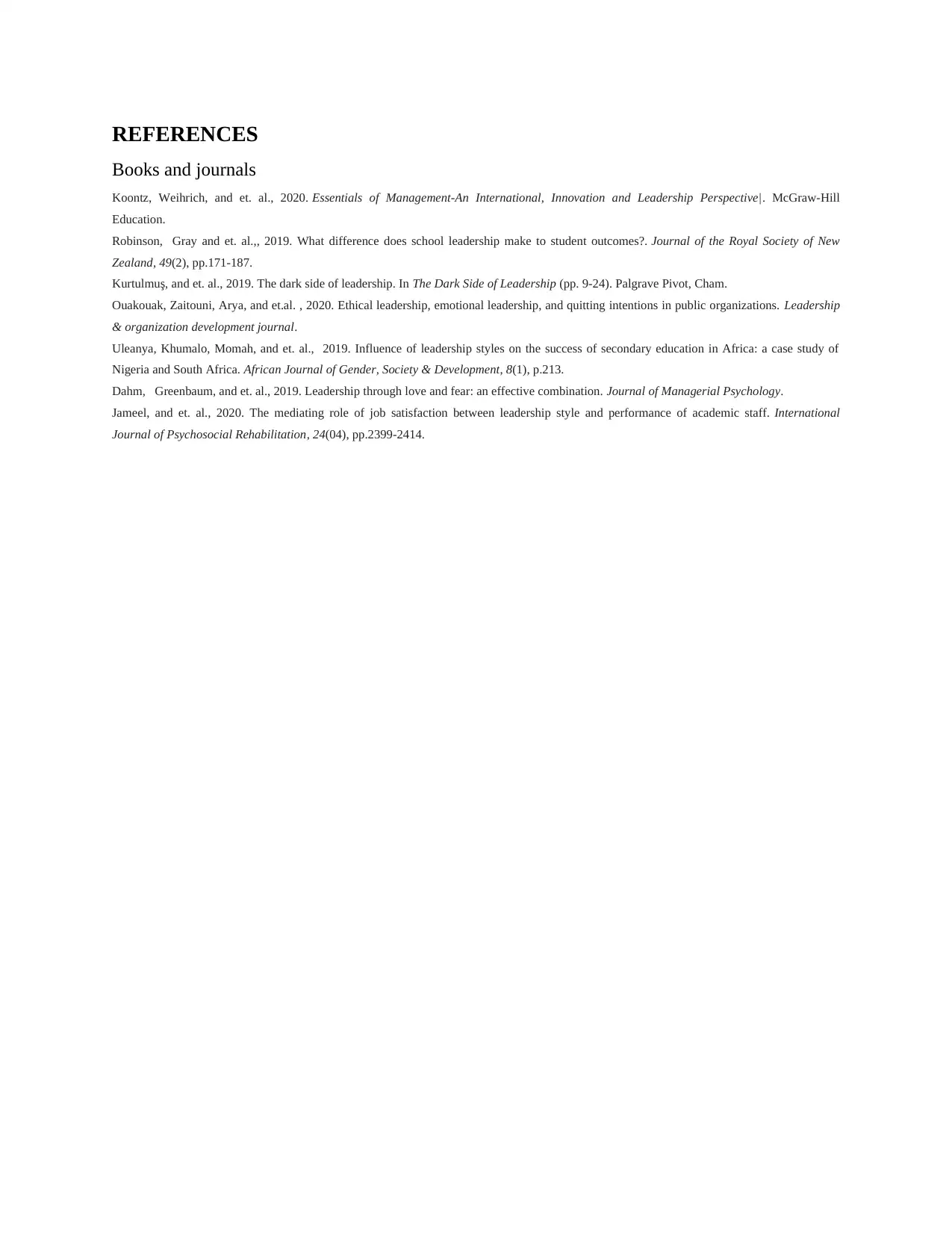
REFERENCES
Books and journals
Koontz, Weihrich, and et. al., 2020. Essentials of Management-An International, Innovation and Leadership Perspective|. McGraw-Hill
Education.
Robinson, Gray and et. al.,, 2019. What difference does school leadership make to student outcomes?. Journal of the Royal Society of New
Zealand, 49(2), pp.171-187.
Kurtulmuş, and et. al., 2019. The dark side of leadership. In The Dark Side of Leadership (pp. 9-24). Palgrave Pivot, Cham.
Ouakouak, Zaitouni, Arya, and et.al. , 2020. Ethical leadership, emotional leadership, and quitting intentions in public organizations. Leadership
& organization development journal.
Uleanya, Khumalo, Momah, and et. al., 2019. Influence of leadership styles on the success of secondary education in Africa: a case study of
Nigeria and South Africa. African Journal of Gender, Society & Development, 8(1), p.213.
Dahm, Greenbaum, and et. al., 2019. Leadership through love and fear: an effective combination. Journal of Managerial Psychology.
Jameel, and et. al., 2020. The mediating role of job satisfaction between leadership style and performance of academic staff. International
Journal of Psychosocial Rehabilitation, 24(04), pp.2399-2414.
Books and journals
Koontz, Weihrich, and et. al., 2020. Essentials of Management-An International, Innovation and Leadership Perspective|. McGraw-Hill
Education.
Robinson, Gray and et. al.,, 2019. What difference does school leadership make to student outcomes?. Journal of the Royal Society of New
Zealand, 49(2), pp.171-187.
Kurtulmuş, and et. al., 2019. The dark side of leadership. In The Dark Side of Leadership (pp. 9-24). Palgrave Pivot, Cham.
Ouakouak, Zaitouni, Arya, and et.al. , 2020. Ethical leadership, emotional leadership, and quitting intentions in public organizations. Leadership
& organization development journal.
Uleanya, Khumalo, Momah, and et. al., 2019. Influence of leadership styles on the success of secondary education in Africa: a case study of
Nigeria and South Africa. African Journal of Gender, Society & Development, 8(1), p.213.
Dahm, Greenbaum, and et. al., 2019. Leadership through love and fear: an effective combination. Journal of Managerial Psychology.
Jameel, and et. al., 2020. The mediating role of job satisfaction between leadership style and performance of academic staff. International
Journal of Psychosocial Rehabilitation, 24(04), pp.2399-2414.
1 out of 11
Related Documents
Your All-in-One AI-Powered Toolkit for Academic Success.
+13062052269
info@desklib.com
Available 24*7 on WhatsApp / Email
![[object Object]](/_next/static/media/star-bottom.7253800d.svg)
Unlock your academic potential
Copyright © 2020–2025 A2Z Services. All Rights Reserved. Developed and managed by ZUCOL.




